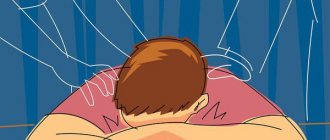Medical information is reliable Checked by Shaidullin Renat Flyurovich
Hallucinosis is a mental disorder in which there is an influx of hallucinations of predominantly one type (visual, olfactory, auditory, etc.) while maintaining the patient’s clear consciousness. Treatment of hallucinosis in Moscow at Dr. Isaev’s clinic is carried out by the most experienced specialists, using modern approaches to therapy.
This condition often occurs as a secondary condition, and therefore help is provided primarily in the form of an impact on the underlying pathology. Before the development of hallucinations, anxiety, fear, and motor restlessness appear, and are often accompanied by delusional ideas of identical types.
Causes and types of hallucinosis
Correct treatment of hallucinosis is impossible without identifying the etiological factor of its development. The main reasons for this deviation are:
- epilepsy;
- traumatic brain injury;
- dysfunction of the central nervous system;
- brain tumors of a benign or malignant nature;
- schizophrenia;
- severe infectious disease;
- withdrawal symptoms and acute alcoholic hallucinosis;
- intracerebral hemorrhage.
Sometimes this pathology occurs in isolation, such as Charles Bonnet hallucinosis, described in elderly patients. But more often it is based on mental or somatic disorders.
Before starting treatment for hallucinosis, it is necessary to determine the type of its course. It can be:
- spicy;
- subacute;
- chronic.
The acute variant occurs suddenly, against the background of complete well-being. It is preceded by a prodromal period, which lasts from 2-3 hours to several days. The subacute variant is characterized by the initial appearance of severe anxiety and fear, depression and frequent mood swings. In this case, treatment for anxiety and the use of sedatives may be necessary. The chronic type of hallucinosis is rare and usually lasts from 2 to 10 years.
Depending on the etiology, the following hallucinatory-paranoid syndromes are distinguished:
- organic (for brain diseases);
- atherosclerotic (has a chronic course with increasing symptoms);
- alcoholic (occurs against the background of giving up alcohol after drinking binges).
Complications and consequences
In most cases, after a course of appropriate therapy, hypertension goes away without consequences for the neurological or mental health of the patient. In rare cases, the following complications are observed:
- delusional syndrome persists for some time;
- during severe stressful experiences, the “voices” return again for several hours, less often - days;
- clinical depression develops.
Of all the listed consequences, only depression requires targeted therapy; other complications soon go away on their own.
A separate problem may be the psychological fixation of patients on memories of hallucinations. Some patients who previously suffered from alcoholic hallucinosis begin to mystify their experience and look for a hidden “higher meaning” or purpose in it. Without the provision of psychotherapeutic assistance, such fixation can lead to the formation of various types of psychoses.
General symptoms of hallucinosis
A common feature for all hallucinosis is the person’s retention of consciousness. The patient understands who he is, what time it is, and where he is. Otherwise, the clinical picture of the problem depends on the type of disease. Charles Bonnet syndrome causes:
- cartoon visions;
- people with distorted facial features;
- hallucinations appear and disappear suddenly;
- The pictures are saved in full.
Often this phenomenon is combined with atherosclerosis, and sometimes accompanies senile dementia, in which case hallucinosis is eliminated and Alzheimer's is treated.
In Lhermitte's disease, hallucinosis manifests itself somewhat differently:
- observed in the dark;
- They look like vague images of animals or people.
In the verbal form of the disease the following are noted:
- voices (one or several);
- they discuss him and his surroundings;
- ordered to perform certain actions.
Treatment of hallucinosis of alcohol origin is carried out after consultation with a narcologist; this type of mental disorder is characterized by the following symptoms:
- high anxiety;
- fear without reason;
- vivid and believable visual images;
- voices coming from objects;
- obsessive thoughts about death or the death of relatives;
- sleep disturbance;
- suicide attempts.
The most common types of hallucinosis:
Alcoholic hallucinosis
Develops in individuals who abuse alcohol and have a predisposition to endogenous diseases. Most often it occurs in the form of verbal hallucinations (in the form of words, phrases, dialogues, songs).
Visual hallucinosis
It can develop in people who have completely or partially lost their vision.
Gabek's olfactory hallucinosis
The patient begins to feel unpleasant odors, which, as it seems to him, come from himself. Characteristic is a decrease in criticism and the appearance of delusional ideas of the attitude: “those around you smell these smells and therefore behave differently.”
Tactile hallucinosis: Ekbom's dermatozoal hallucinosis
The patient feels crawling and moving on his skin. This causes scratching, itching and general anxiety. The sensations are so believable that patients often refuse to accept the true nature of their complaints and spend a lot of energy on unnecessary tests and consultations to search for imaginary parasites.
Features of organic hallucinosis
When a deviation occurs, the person is fully conscious and can think critically about the problem. Treatment of hallucinosis in Moscow is carried out mainly in people from 45 to 65 years old, most often women become patients.
Numerous experimental works by scientists indicate that hallucinations arise as a result of irritation of certain parts of the brain. Most often, the organic form of hallucinosis occurs due to the presence of intoxication due to an infectious disease, neurological or vascular disease, or disruption of the functioning of the sensory organs. The following factors can provoke the appearance of this deviation:
- taking psychostimulants (alcoholism and drug addiction);
- drug poisoning;
- damage to brain tissue by tumor, injury;
- epilepsy;
- migraine with pre-existing aura;
- oxygen starvation of brain structures due to vascular disorders;
- deafness and blindness.
With this form of disorder, the patient’s comprehension of what is happening is slower than that of a healthy person. This phenomenon is often used in the diagnosis of deviation. Treatment of hallucinosis in this case is necessary, since the disease can progress rapidly and lead to severe apathy and memory impairment. The patient also exhibits the following symptoms:
- poverty of associations;
- reluctance to engage in conversations;
- emotional stinginess;
- lethargy and dysphoria;
- causeless aggression (sometimes);
- impulsiveness;
- difficulty controlling emotions;
- stereotypical speech and thinking.
Causes of mental disorder
Any alcoholic hallucinosis is a consequence of abuse of alcohol-containing drinks at the level of chronic alcoholism. Approximately half of those who exhibit symptoms of this disorder suffer from stage II of the disease. In the other part, phase III is detected.
The development of psychotic disturbances is facilitated by:
- Malignant course of alcohol addiction.
- Concomitant neurological pathology.
- Traumatic injuries, inflammatory and degenerative diseases of the brain, alcoholic encephalopathy.
- Co-occurring abuse of other psychoactive substances.
- Large doses of alcohol taken.
The course of alcoholic hallucinosis
Treatment of hallucinosis caused by drinking alcohol-containing strong drinks is carried out in a drug treatment clinic or a specialized department. Its main difference from alcoholic delirium is that the patient remains conscious and is able to navigate in space.
In this case, a person experiences predominantly auditory hallucinations, most often accompanied by delusions. He hears voices from the outside that threaten to kill him or the cries of his children and loved ones asking for help. Sounds can be monotonous or increasing in nature, disappear and appear again.
This phenomenon causes the formation of paranoid tendencies, when treatment of persecutory mania, severe fear and anxiety may be required. The appearance of such a disorder is preceded by a change in mood, which the patient characterizes as severe melancholy and reluctance to live.
Alcoholic hallucinosis occurs with prolonged consumption of large doses of alcohol. Most often it is registered in people who have been drinking for 10-15 years or more, in the second or third stage of addiction. Tolerance to ethyl alcohol in such patients is usually higher than in persons with manifestations of delirium. There are studies proving that hallucinosis occurs when ethanol and its breakdown products damage the hypothalamus in the body. And withdrawal syndrome further provokes the formation of this deviation.
Types of hallucinations
With hallucinosis, perception is impaired. The patient hears, sees or feels something that does not really exist. There are three categories of such disorders, in accordance with the three senses “responsible” for them.
Visual
With such hallucinosis, the patient sees objects that do not exist in reality. These may be fleeting, elusive images on the periphery of vision. They disappear if you try to look at them and focus. Visions can be clear and vivid. An elderly person can see his friends or relatives, animals, mythical creatures and even communicate and interact with them.
Auditory
Usually progresses: the first hallucinations are manifested by simple sounds. It seems to the patient that something is knocking, rustling, or rattling somewhere, but the source of the noise cannot be found. Gradually the sounds become more complex, he can hear speech and addresses addressed to him. More often they are negative in nature, these are accusations, insults, threats. With auditory hallucinations, a person may communicate with voices that only he or she can hear.
Tactile
They manifest themselves as unpleasant sensations: the patient experiences itching, it seems to him that insects and parasites are running over the skin. He may even see them if the disorder is accompanied by visual hallucinosis. The sensation may be accompanied by burning and pain. This interferes with sleep, irritates, increases anxiety, which is why a person’s mental state worsens.
Hallucinations related to smell or taste are relatively rare in older people.
You have questions? We will call you back within 30 seconds
or call the number
Clicking the "Submit"
, you automatically consent to the processing of your personal data and accept the terms of the User Agreement.
How is the disease diagnosed?
Treatment of hallucinosis in Moscow and other cities is based primarily on the diagnosis. He identifies according to the clinical picture and characteristic manifestations of the disease. For an experienced neurologist, narcologist or psychiatrist, it is usually not particularly difficult to establish this disorder. This requires:
- study medical history;
- get acquainted with the medical history;
- observe the patient for some time;
- conduct a series of neurological tests;
- interview the patient and his relatives in detail.
With primary hallucinosis, this is enough. If it acts as a secondary manifestation of the underlying disease, then laboratory and instrumental studies are required. They will confirm or exclude the presence of organic lesions that cause hallucinations. Usually prescribed:
- electroencephalogram;
- MRI and CT scan of the brain;
- Ultrasound examination of his vessels.
Treatment of hallucinosis of organic origin is carried out only after excluding other diseases that occur in a similar way:
- drug or alcohol psychosis;
- schizophrenia;
- mental disorders accompanied by delusional ideas.
If hallucinations develop during psychosis when using ethyl alcohol or psychotropics, visions and hallucinations occur, but the person’s clarity of consciousness is not determined. Schizophrenics often experience pseudohallucinations, delusions, and a lack of criticality towards their condition. In this case, consultation with a psychiatrist will help differentiate the pathology. With a delusional disorder, delusion comes first, then it is primary and requires a slightly different approach to providing assistance.
Total information
For every 5 cases of delirium tremens, there is 1 hallucinatory delusion. It develops mainly in the 10-11th year of alcoholism, but not earlier than 7-8 years after the development of stage I. The age range of those in need of help is 30-50 years. Most patients are aged 40 years. Women get sick more often than men in a ratio of 2:1. Dominant symptom: auditory hallucinations. Voices are of the most diverse nature and can be both single and multiple. The fear that accompanies them leads the patient to delusions of persecution and attempts to “protect” himself from them. In this state, the patient can cause injuries and mutilation to himself and others. Suicide attempts are common. With this painful status, mandatory inpatient care is required.
Organic hallucinosis treatment
Treatment of hallucinosis in Moscow, which has an organic origin, is becoming increasingly relevant. Experts attribute this to the increase in people's life expectancy, which increases the number of special cases of senile mental disorders. A large amount of stress experienced and constant tension in the nervous system, characteristic of a resident of a large metropolis, lead to a high risk of developing various diseases. The complexity of therapy in this case is determined by the selection of drugs that can be used in elderly people.
Most often, combination therapy of two drugs, which may belong to different groups, is used. Treatment of hallucinosis begins with minimal doses with a gradual increase, and continues until a satisfactory clinical picture is obtained at a maintenance dosage. Usually used in different combinations:
- neuroleptics;
- anticonvulsants;
- antipsychotics;
- anti-anxiety medications;
- antidepressants.
Therapy is also aimed at eliminating or reducing the influence of the underlying disease and, if the course is mild and there is no danger to the patient and others, it can be carried out on an outpatient basis. Severe forms of organic hallucinosis require hospital care. It makes it easier to prescribe treatment and monitor the body’s reaction to a particular drug.
Treatment and prevention of delirium tremens at home
Manifestations of alcoholic delirium can be accompanied by quite dangerous consequences. What to do if you have delirium tremens?
First of all, in a state of violent insanity, it is necessary to put the patient in bed and monitor him until the ambulance arrives. In folk medicine, it is recommended to apply ice (or something cold) to the forehead and follow a drinking regime. The more liquid, the better. Also, one of the fundamental symptoms of delirium is a sleep disorder, which it is advisable to normalize with the help of sedatives and hypnotics. And the most basic advice is to control the patient’s behavior and actions. In a state of hallucinosis and mental confusion, a person can jump out of a window. Fleeing from an illusory danger or start waving heavy objects at hand, which is dangerous not only for himself, but also for those around him.
As for prevention, the only method is a healthy lifestyle and careful attention to your body and psyche. It is known that withdrawal syndrome does not occur in the early stages of alcoholism, so the only recommendation is not to start drinking, or better yet, not to start drinking at all.
Alcoholic hallucinosis treatment
Treatment of hallucinosis of alcoholic origin is carried out in a narcology setting. Therapy in this case has the following goals:
- carrying out intensive detoxification;
- elimination of mental disorders;
- normalization of metabolic processes;
- restoration of organ function;
- prevention of cognitive impairment.
To remove toxic products of ethanol, saline solutions with glucose, adsorbents, B vitamins, and ascorbic acid are used. At the same time, cerebral circulation is improved with the help of nootropics, and symptomatic therapy is selected individually.
In acute manifestations of the disease, parenteral administration of antipsychotics and tranquilizers is practiced. Treatment of hallucinosis in alcoholics should begin as quickly as possible, only in this case is it possible to get rid of the pathology in a short time. With chronic hallucinases, it is necessary to resort to more radical and lengthy methods of therapy. A prerequisite for recovery is a complete abstinence from drinking alcoholic beverages.
To consolidate the result after relieving an acute condition, it is necessary to visit “Alcoholics Anonymous” groups and work with a psychotherapist. The specialist will teach you how to enjoy life without resorting to the use of psychotropics and alcohol. It will also help improve relationships in the family and at work. You can undergo complete social rehabilitation in a specialized center.
Treatment of hallucinosis in acute alcoholism lasts no more than a month. A number of patients remain depressed (more often in women), and may require additional treatment for dysthymia, which can be easily treated with selective serotonin reuptake blockers. The chronic form of the disorder, provided there is no influence of ethyl alcohol on the body, can occur in the form of long-term remissions and exacerbations under provoking factors (stress, fatigue). In this case, a person’s intellectual abilities do not suffer.
Symptoms
Hallucinosis is manifested by the presence of deceptions of perception, relatively constant and homogeneous. For example, this can occur in the form of the presence of “voices” (auditory deceptions), pictures and images (visual deceptions), unpleasant odors (olfactory deceptions), tastes (gustatory deceptions), sensations of touch or pressure (tactile hallucinosis). The difference between hallucinosis is complete clarity of consciousness: orientation in time, place and one’s own personality is completely preserved, all events are fully preserved in memory.
With hallucinosis, delusional ideas may arise, but they are usually unstable and fully correspond to the content of hallucinations. For example, a patient experiencing olfactory hallucinations in the form of unpleasant odors concludes that there is a corpse in the next room. Or, if there are auditory deceptions in the form of voices, he begins to believe that there are people behind the wall who are emitting these voices.
Questions and answers
Is it possible to get rid of hallucinosis completely?
It is difficult to predict the result with this deviation. Much depends on the underlying disease that causes hallucinosis. It is necessary to detect it as early as possible, and in this case, doctors have a much higher chance of achieving a positive result.
What will happen if treatment is not carried out?
In the complete absence of therapy, a person’s condition is highly likely to worsen. He can become dangerous to himself and his surroundings. Severe depression, which often accompanies advanced cases, often leads to suicide attempts. The development of behavioral and emotional disorders, a decrease or complete cessation of social activity is possible.
Forms and classification
Due to the fact that every alcoholic “drinks differently,” the forms and manifestations of the disease can vary significantly. Symptomatic manifestations and the onset of one or another stage depend on parameters such as the patient’s age, the presence of other diseases, the frequency, quantity and type of alcoholic beverages he drinks.
- The most common type of alcoholic delirium is classic . It is characterized by the entire set of previously described symptoms. It is important to note that this form develops quite gradually, and before acute psychosis the patient can drink alcohol for a long period of time.
- The lucid form develops very quickly, almost suddenly, and there is no hallucinosis and symptoms of delirium, but acute hypochondriacal neurosis, insurmountable fear and somatic disorders expressed in impaired coordination are present.
- In the abortive form, delusions and hallucinations are observed, but they are not pronounced. But anxiety and depression are strongly manifested.
- The professional form demonstrates amnesia; the patient may forget events not only that happened recently, but also significant moments of the past. Motor stereotypy is also present - the patient is unable to perform complex actions. This form has similar symptoms to dementia.
- Mussitating is a certain kind of continuation of the professional form. In addition to problems with the perception of reality and the ability to perform normal activities, the patient develops serious diseases of the internal organs.
- Atypical - unlike professional, it has symptoms similar to schizophrenic disorder. There is vivid delirium, persecutory delusions, very acute hallucinations and somatic disorders. Amnesia may also occur.
Alcohol delirium: signs
One of the groups of psychopathologies characterized by the formation of delusions is alcoholic delusions . Delusional disorder manifests itself in groundless attacks of aggression, jealousy, paranoia, and persecution mania.
An inadequate reaction to what is happening is provoked by chronic alcoholism . At the same time, the alcoholic experiences fear, anxiety, and worry. The behavior of an alcoholic is impulsive and unpredictable, devoid of any logic. Attacks of delusional psychosis can have varying intensity, worsen and subside over the course of the day, or appear evenly over a long period of time.
Alcoholic psychosis in any form is a borderline state with many other mental illnesses. Only a narcologist-psychiatrist at a medical center can diagnose the type of alcoholic delusional disorder and select the necessary course of treatment.
Literature:
- Chronic alcoholic hallucinosis / Dr. med. Sciences I. V. Strelchuk; With a preface valid member Academician honey. sciences, prof. M. O. Gurevich; Clinical neuropsychiatrist Moscow City Health Department Hospital. — Moscow: Type. publishing house "Mosk. Bolshevik", 1947. - 144 p.
- Penionzhek, Evgenia Vladimirovna.
- Psychiatry: textbook / E. V. Penionzhek; Federal State Treasury Educational Institution of Higher Education "Ural Law Institute of the Ministry of Internal Affairs of the Russian Federation", Department of General Psychology and Humanitarian Disciplines. — Ekaterinburg: Ural Law Institute of the Ministry of Internal Affairs of Russia, 2021. — 175 p.
- A manual on narcology for doctors and paramedics of primary medical care / A. A. Churkin, T. V. Klimenko. - Moscow ; Khanty-Mansiysk: Health and Society, 2006 (Cheboksary: IPK Chuvashia). — 173 p.
- The doctrine of hallucinations / V. A. Gilyarovsky. — 4th ed. (electronic). — Moscow: Binom. Lab. knowledge, 2012. - 224 p.
The text was checked by expert doctors: Head of the socio-psychological service of the Alkoklinik MC, psychologist Yu.P. Baranova, L.A. Serova, a psychiatrist-narcologist.
CAN'T FIND THE ANSWER?
Consult a specialist
Or call: +7 (495) 798-30-80
Call! We work around the clock!
Treatment of acute psychosis after binge drinking
All victims with suspected alcohol use disorders are subject to mandatory hospitalization in a hospital. Strict measures are due to the risk of harm to oneself (suicide) or others. The danger is eliminated only after timely relief of all symptoms.
Medication
Patients must be under 24-hour staff supervision. Therapeutic assistance consists of the following activities:
- Emergency detoxification is the rapid removal of ethanol and its metabolites from tissues. Methods of forced diuresis and extracorporeal blood purification (hardware hemodialysis, plasmapheresis) are used.
- Rehydration – combating dehydration with the help of detoxifying liquids.
- Infusion therapy - droppers containing solutions to eliminate electrolyte imbalance, hypovitaminosis, and metabolic changes.
- Normalization of respiratory and circulatory functions.
- Prevention or emergency relief of acute kidney/liver damage.
- Treatment of concomitant pathology.
- Fighting pulmonary and cerebral edema.
- Motor agitation is treated with benzodiazepine tranquilizers.
- Psychotropic drugs – neuroleptics, antidepressants.
- Repeated courses of multicomponent vitamin therapy.
Treatment is supplemented with nootropic drugs, for example, piracetam. However, they show minimal effectiveness as part of complex therapy. The length of hospital stay depends on the severity of the general condition.
Psychotherapy
In case of chronic complications, patients are selected an individual program of psychotherapeutic assistance. Personal and group, family consultations help maintain a stable condition. The measures taken increase the effectiveness of pharmaceutical treatment and slow down the progression of the general disease.










